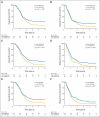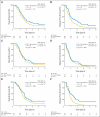Cellular histone modification patterns predict prognosis and treatment response in resectable pancreatic adenocarcinoma: results from RTOG 9704
- PMID: 20142597
- PMCID: PMC2834495
- DOI: 10.1200/JCO.2009.24.5639
Cellular histone modification patterns predict prognosis and treatment response in resectable pancreatic adenocarcinoma: results from RTOG 9704
Abstract
PURPOSE Differences in cellular levels of histone modifications have predicted clinical outcome in certain cancers. Here, we studied the prognostic and predictive value of three histone modifications in pancreatic adenocarcinoma. METHODS Tissue microarrays (TMAs) from two pancreatic adenocarcinoma cohorts were examined, including those from a 195-patient cohort from Radiation Therapy Oncology Group trial RTOG 9704, a multicenter, phase III, randomized treatment trial comparing adjuvant gemcitabine with fluorouracil and a 140-patient cohort of patients with stage I or II cancer from University of California, Los Angeles Medical Center. Immunohistochemistry was performed for histone H3 lysine 4 dimethylation (H3K4me2), histone H3 lysine 9 dimethylation (H3K9me2), and histone H3 lysine 18 acetylation (H3K18ac). Positive tumor cell staining for each histone modification was used to classify patients into low- and high-staining groups, which were related to clinicopathologic parameters and clinical outcome measures. Results Low cellular levels of H3K4me2, H3K9me2, or H3K18ac were each significant and independent predictors of poor survival in univariate and multivariate models, and combined low levels of H3K4me2 and/or H3K18ac were the most significant predictor of overall survival (hazard ratio, 2.93; 95% CI, 1.78 to 4.82) in the University of California, Los Angeles cohort. In subgroup analyses, histone levels were predictive of survival specifically for those patients with node-negative cancer or for those patients receiving adjuvant fluorouracil, but not gemcitabine, in RTOG 9704. CONCLUSION Cellular levels of histone modifications define previously unrecognized subsets of patients with pancreatic adenocarcinoma with distinct epigenetic phenotypes and clinical outcomes and represent prognostic and predictive biomarkers that could inform clinical decisions, including the use of fluorouracil chemotherapy.
Conflict of interest statement
Authors' disclosures of potential conflicts of interest and author contributions are found at the end of this article.
Figures






Similar articles
-
The cellular level of histone H3 lysine 4 dimethylation correlates with response to adjuvant gemcitabine in Japanese pancreatic cancer patients treated with surgery.Eur J Surg Oncol. 2012 Nov;38(11):1051-7. doi: 10.1016/j.ejso.2012.08.008. Epub 2012 Sep 6. Eur J Surg Oncol. 2012. PMID: 22959167
-
dCK expression correlates with 5-fluorouracil efficacy and HuR cytoplasmic expression in pancreatic cancer: a dual-institutional follow-up with the RTOG 9704 trial.Cancer Biol Ther. 2014 Jun 1;15(6):688-98. doi: 10.4161/cbt.28413. Epub 2014 Mar 11. Cancer Biol Ther. 2014. PMID: 24618665 Free PMC article.
-
Adjuvant PEFG (cisplatin, epirubicin, 5-fluorouracil, gemcitabine) or gemcitabine followed by chemoradiation in pancreatic cancer: a randomized phase II trial.Ann Surg Oncol. 2012 Jul;19(7):2256-63. doi: 10.1245/s10434-011-2205-2. Epub 2012 Jan 12. Ann Surg Oncol. 2012. PMID: 22237835 Clinical Trial.
-
Management of locally advanced adenocarcinoma of the pancreas.Hematol Oncol Clin North Am. 2002 Feb;16(1):95-103. doi: 10.1016/s0889-8588(01)00009-0. Hematol Oncol Clin North Am. 2002. PMID: 12063831 Review.
-
Role of solute carrier transporters in pancreatic cancer: a review.Pharmacogenomics. 2014 Jun;15(8):1133-45. doi: 10.2217/pgs.14.80. Pharmacogenomics. 2014. PMID: 25084206 Review.
Cited by
-
Quantitative Mass Spectrometry Reveals that Intact Histone H1 Phosphorylations are Variant Specific and Exhibit Single Molecule Hierarchical Dependence.Mol Cell Proteomics. 2016 Mar;15(3):818-33. doi: 10.1074/mcp.M114.046441. Epub 2015 Jul 24. Mol Cell Proteomics. 2016. PMID: 26209608 Free PMC article.
-
Epigenetic regulation of pancreatic adenocarcinoma in the era of cancer immunotherapy.J Gastroenterol. 2022 Nov;57(11):819-826. doi: 10.1007/s00535-022-01915-2. Epub 2022 Sep 1. J Gastroenterol. 2022. PMID: 36048239 Free PMC article. Review.
-
HOXB7 promotes invasion and predicts survival in pancreatic adenocarcinoma.Cancer. 2013 Feb 1;119(3):529-39. doi: 10.1002/cncr.27725. Epub 2012 Aug 22. Cancer. 2013. PMID: 22914903 Free PMC article.
-
Metabolic Regulation of Lysine Acetylation: Implications in Cancer.Subcell Biochem. 2022;100:393-426. doi: 10.1007/978-3-031-07634-3_12. Subcell Biochem. 2022. PMID: 36301501 Review.
-
Systemic therapies for pancreatic cancer--the role of pharmacogenetics.Curr Drug Targets. 2012 Jun;13(6):811-28. doi: 10.2174/138945012800564068. Curr Drug Targets. 2012. PMID: 22458528 Free PMC article. Review.
References
-
- Hezel AF, Kimmelman AC, Stanger BZ, et al. Genetics and biology of pancreatic ductal adenocarcinoma. Genes Dev. 2006;20:1218–1249. - PubMed
-
- Bernstein BE, Meissner A, Lander ES. The mammalian epigenome. Cell. 2007;128:669–681. - PubMed
-
- Ting AH, McGarvey KM, Baylin SB. The cancer epigenome: Components and functional correlates. Genes Dev. 2006;20:3215–3231. - PubMed
-
- Esteller M. Cancer epigenomics: DNA methylomes and histone-modification maps. Nat Rev Genet. 2007;8:286–298. - PubMed
Publication types
MeSH terms
Substances
Grants and funding
LinkOut - more resources
Full Text Sources
Other Literature Sources
Medical
Molecular Biology Databases

